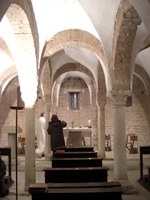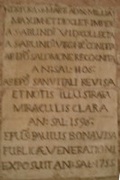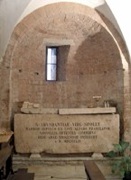


The crypt is has a semi-circular apse and two apsidal chapels. Columns (mostly 11th century) with interesting capitals separate the rest of the space into a nave and four aisles. [Identify capitals and columns from earlier buildings]
A funerary cippus (perhaps 6th century) with a Christian inscription has been re-used as the base of the altar.

-
✴10,000 people were martyred in Spoleto under the Emperors Maximian and Diocletian.
-
✴St Abbondanza (the widow) rescued their bodies for burial.
-
✴St Abbondanza (the virgin) built an oratory dedicated to them.
-
✴Bishop Salomone recognised the relics in 1106.
-
✴Bishop Paolo Sanvitale recognised the relics in 1596.
-
✴Bishop Paolo Bonavisa exposed the relics for public veneration in 1755.

The original cover of the sarcophagus has been lost. The cover that was used until 1854 is now in the Museo Archeologico: it was originally the grave stone (312 AD) of Florio Baudioni, a soldier in the Emperor Constantine's army who died during Constantine's march on Rome. [CIL IX 4787]
Archeological finds from the Crypt
Inscription (2nd century AD)
This inscription (CIL XI 4813) records a dedication by four officials of the guild of “Scabillares”: these were musicians who accompanied themselves on the scabillium, a pair of hinged wooden plates attached to their sandals that they used to beat time. The dedication was to their patron, the Quattuorviro Marcus Settimius Settimianus and it probably came from the base of a statue that they had erected in his honour.
Bishop Paolo Sanvitale moved the inscription from the crypt to the Palazzo Comunale in 1591. It is now in the Museo Archeologico.

